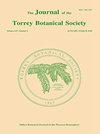几种柱头科和圆头科植物末端关节失效所必需的力
IF 0.8
4区 生物学
Q4 PLANT SCIENCES
引用次数: 0
摘要
EVANS, l.s.(植物形态发生实验室,生物科学研究实验室,曼哈顿学院,布朗克斯,纽约10471),Z. KAHN-JETTER(机械工程系,曼哈顿学院,布朗克斯,纽约10471)和S. BUTWELL(植物形态发生实验室,生物科学研究实验室,曼哈顿学院,布朗克斯,纽约10471)。几种仙人掌属和仙人掌属植物末端关节机械失效所必需的力。托里·博特。《社会科学》131:311-319。2004.近200种柱头属和圆头属植物的茎节数量(株高)和排列取决于茎节之间的连接处的机械应力,以及连接中承受连接破坏的内部成分的数量。对5种柱头花属和圆花属植物的末端关节(末端和次末端茎段之间的关节)进行了应力测试。这5种仙人掌的惯性矩、破坏时最大弯曲应力和节点破坏时弯矩分别为0.22 ~ 50.9 10-9 m4、1060 ~ 12200 kPa和0.45 ~ 2.39 N-m。研究结果表明,试验前弯曲应力较大的末端接头在应力测试中承受较大的应力。这一结果表明,节理是“预应力”的,当它们在植物上自然发育时,具有有限的阻力。结果表明:在应力测试过程中,末端节理受拉破坏时的最大弯曲应力[破坏强度斜率M / (I/c)]大于受压破坏时的最大弯曲应力,受压破坏时的最大弯曲应力大于受拉破坏时的最大弯曲应力。拉伸部分的高抗弯性与末端节理拉伸部分木质化木质部细胞(优势木细胞)的总面积较大有关。我们得出结论,拉伸部分的力学性能与末端节点的压缩部分不相似。此外,节理的断裂强度与节理中木质化细胞的数量呈正相关。总的来说,结果表明仙人掌物种的每个末端关节都有先天的抗失败能力(承受特定水平的机械应力的能力),这是在关节的自然发育过程中建立的。本文章由计算机程序翻译,如有差异,请以英文原文为准。
Forces Necessary for Mechanical Failure of Terminal Joints of Several Species of Cylindropuntia and Opuntia (Cactaceae)
EVANS, L. S. (Laboratory of Plant Morphogenesis, Biological Sciences Research Laboratories, Manhattan College, the Bronx, NY 10471), Z. KAHN-JETTER (Department of Mechanical Engineering, Manhattan College, the Bronx, NY 10471) AND S. BUTWELL (Laboratory of Plant Morphogenesis, Biological Sciences Research Laboratories, Manhattan College, the Bronx, NY 10471). Forces necessary for mechanical failure of terminal joints of several species of Cylindropuntia and Opuntia (Cactaceae). J. Torrey Bot. Soc. 131: 311-319. 2004.The number (plant height) and arrangement of stem segments of the nearly 200 species of Cylindropuntia and Opuntia depend upon mechanical stresses at joints between stem segments in relation to the amount of internal components in joints that withstand joint failure. Stress tests were performed on terminal joints (joints between terminal and sub-terminal stem segments) of five species of Cylindropuntia and Opuntia. For these five cactus species, moment of inertia, maximum bending stress at failure, and bending moment at joint failure values ranged from 0.22 to 50.9 10-9 m4, 1060 to 12200 kPa, and 0.45 to 2.39 N-m, respectively. Results of this study show that terminal joints with larger bending stresses prior to experimentation withstood larger stresses imposed during stress testing. This result indicates that joints are 'pre-stressed' and have a finite level of resistance when they develop naturally on the plant. Results show that maximum bending stresses at failure [breaking strengthslope of M / (I/c)] were higher for tensile than for compressive portions of terminal joints and joint angle deflections changed more for compressive joint portions than for tensile joint portions during stress testing. The high resistance to bending for tensile portions corresponded to a larger total area of lignified xylem cells (the preponderant wood cells) in tensile portions of terminal joints. We conclude that the mechanical properties of tensile portions are not similar to compressive portions of terminal joints. Moreover, the breaking strength of joints was positively correlated with the amounts of lignified cells in joints. Overall, the results imply that each terminal joint for a cactus species has an innate resistance to failure (ability to withstand a specific level of mechanical stress) that is established during the natural development of the joint.
求助全文
通过发布文献求助,成功后即可免费获取论文全文。
去求助
来源期刊
CiteScore
0.70
自引率
0.00%
发文量
16
审稿时长
>12 weeks
期刊介绍:
The Journal of the Torrey Botanical Society (until 1997 the Bulletin of the Torrey Botanical Club), the oldest botanical journal in the Americas, has as its primary goal the dissemination of scientific knowledge about plants (including thallopyhtes and fungi). It publishes basic research in all areas of plant biology, except horticulture, with an emphasis on research done in, and about plants of, the Western Hemisphere.

 求助内容:
求助内容: 应助结果提醒方式:
应助结果提醒方式:


